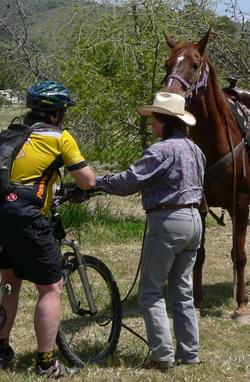




By Kathy Dombrowski
Efforts to help different activities on multi-use trails get along better and to improve safety.

These suggestions on Horse Safety come from discussions at a OHV/Horse/bike meeting. This is a part of a group that was set up nationally after the Folsom Lake State Recreation Area (CA) trail accident. That happened in January 2009 where two riders were injured and a horse had to be put down. This information will be used by the group to make up pamphlets that will be available to all trail user groups. The idea is to see that each user groups concerns and needs are addressed. Hopefully this will help when riders meet on the trail.
-- Kathy Dombrowski
Horses are prey animals and as such regardless if they have been exposed to outside stimulus such as dirt bikes, ATV’s cars and trucks or hikers and runners on a trail, they can still go into the prey mode if startled by a loud unseen noise (dirt bike or ATV) coming at them. Same is true of a bike or even a runner/hiker on a trail. If there is a sharp curve or no line of site and trail users all need to slow down.
A hiker/jogger should always slow down and stop when they see horses on the trail ahead or behind them. Stop and greet the rider so the horse knows you are human.
If you have a young inexperienced horse, ride behind another horse that is more trail wise. The younger horse will work off the older one. Time and hours on the trail will build confidence in the youngster. Horse groups should have the steadiest horse up front.
Riders should be aware of traffic ahead. Check the trail for tracks and droppings. This will help you not be surprised that there other trail users in your area.
Have your pets under control. Dogs should be on a leash if rule of the trail calls for that. If ponying another horse go slow, do not take a loose horse on the trail with you.
Before you ride a trail, know the rules for that trail, if there are speed limits, usage limits (pedestrian/equestrian trail, multiuse trail that permits bikes, if OHV are permitted. Ride only on trails that you are permitted on. Follow all trail rules, know your contact number if there is an incident, program it into your cell phone.
With the use of common sense and courtesy on the trail there will not be the need for a referee to oversee our sports.
Always approach BLIND CURVES and areas where there is poor line of site with CAUTION and look out for other trail users.
A hiker with a back pack and/or walking stick can look very frightening to a horse, Let the horse and rider know that you are human by saying “Hi”. When a horse hears a human voice they will calm down.
Dirt bike engines can be a real horse frightening experience. When racing the throttle, remember there may be panic-stricken horse and airborne rider around the next turn. Go slow on the blind corners.
Bikes should have bells when riding multiuse trails so they can warn others they are coming if line of sight is poor. Follow speed limits and bell rules from East-Bay Trail Organization. I understand that IMBA has even recommended this on some of the Multiuse trails.
Horses must also follow speed limits if posted on trails being ridden.
Only ride on trails that permit horses. Same for other users. Follow trail use rules as to what the trail use is.
Be courteous to all users.
Leave no trace
Night riding only where permitted.
Preserve our right to ride on public land by following the rules. It is your responsibility to know the rules and regs of the trails you ride or use. Stay on the trail, do not cut across switchbacks. Watch speed in areas of poor line of site. Do not smoke or drink on the trail.